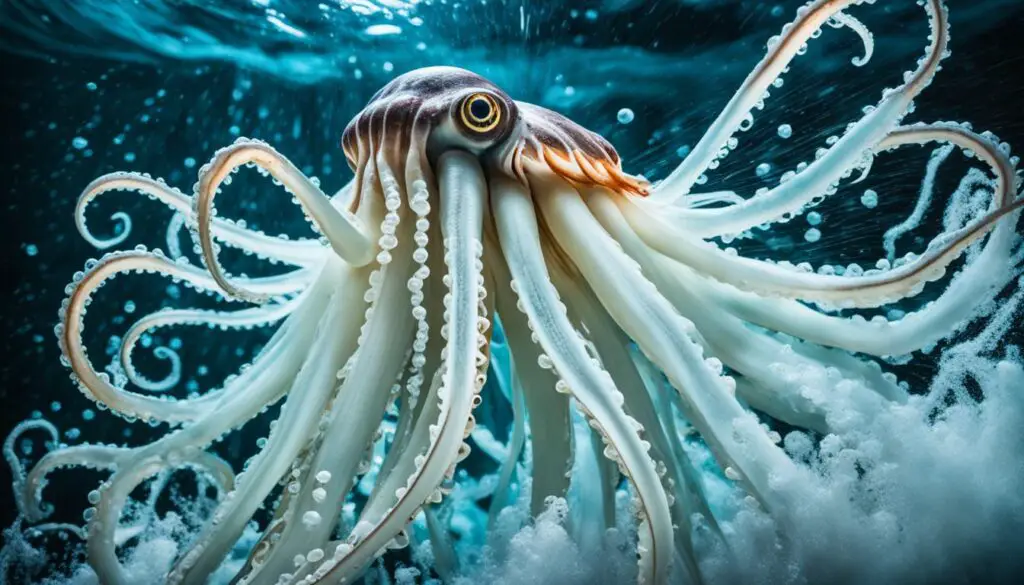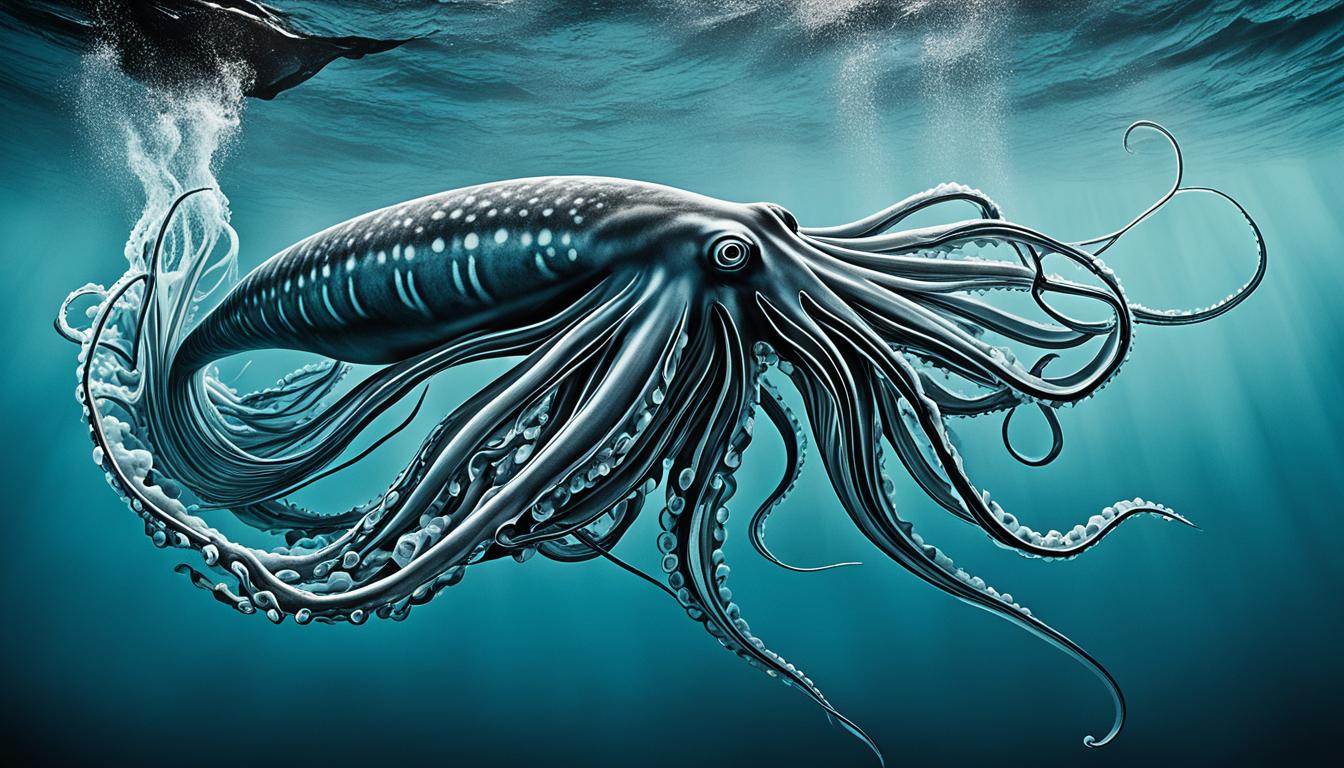Giant squids, like Architeuthis dux, are huge and fascinating creatures of the deep sea. They can grow up to 13 meters long. Knowing how they move is key to understanding their secrets. They have special ways to swim in the dark ocean.
Their body structure and swimming methods are quite interesting. These features help them hunt and play a big role in their ecosystem. Let’s dive into what makes their movement unique.
Understanding Giant Squid Anatomy
The anatomy of the giant squid is truly fascinating. It shows us the complexity of its body and how it adapts to life in the deep ocean. By studying its anatomy, we learn how this mysterious creature survives in the deep.
Body Structure and Limbs
The giant squid has a unique body with eight arms and two long feeding tentacles. These limbs have suckers that help the squid catch prey from far away. Its large eyes, up to 30 centimeters wide, let it see in the dark depths where it lives.
The Importance of the Mantle
The mantle is key to the giant squid’s anatomy. It covers important organs and supports its special body shape. The strong muscles in the mantle help the squid move fast to escape or hunt.
Learning about the mantle shows us how squids have evolved to live in tough places.
Function of the Siphon
The siphon is a vital part of the giant squid’s body. It’s used for exhaling water, laying eggs, and even for fast movement. By pushing water out through the siphon, the squid can swim quickly and avoid predators.
This shows how well giant squids have adapted to life deep in the ocean.
How do giant squids move?
Giant squids have amazing ways to move through the ocean. They mainly use jet propulsion to move fast and agilely. This method helps them survive and hunt in the deep sea.
Jet Propulsion Mechanism
The way giant squids jet propel is both efficient and interesting. They take water into their mantle cavity, which acts as a tank. Then, they push the water out through the siphon with great force.
This creates a strong backward thrust. It lets them quickly move away from danger or chase prey. This is key for escaping predators and hunting effectively.
The Role of Fins in Navigation
Jet propulsion gives them speed, but their fins help with steering. The small fins along their body help them change direction. These fins make their movements precise and flexible.
This mix of jet propulsion and fin steering makes their swimming style adaptable and efficient. It helps them move through the water with ease.

Giant Squids Swimming Behavior
Giant squids have fascinating ways of swimming that help them survive in the deep ocean. Their movements show special adaptations for hunting and reacting to their surroundings.
Movement Patterns in the Deep Ocean
In the vast, dark ocean, giant squids move in unique ways. They use a jet propulsion method to swim fast to avoid predators or catch prey. They change how they swim, using a mix of:
- Stealth swimming, where they glide quietly to ambush unsuspecting prey.
- Speed bursts that allow them to escape threats quickly.
- Curved movements that assist in maneuverability through complex underwater topographies.
Responses to Environmental Stimuli
How giant squids react to their environment is crucial. Changes in water temperature, depth, and the presence of prey or predators affect their behavior. For instance:
- When they sense prey, they swim faster and change direction to catch it.
- When threatened, they move cautiously, sometimes staying still to hide.
- Changes in water pressure make them adjust their swimming to fit their deep-sea home.
Giant Squids Propulsion Mechanisms
Giant squids have a special way of moving through the deep ocean. They use a mix of anatomy and physics for this. This lets them swim fast and interact with their surroundings in a unique way. Let’s explore how they move and how they interact with the water.
Understanding Jet Propulsion Dynamics
Giant squids have a powerful jet propulsion system. This system helps them move quickly and efficiently. Their siphon is key, pushing water out forcefully to push them forward.
The strength and direction of the water expelled control their speed and path. This skill lets them catch prey quickly and avoid dangers in the deep sea.
Interaction with Surrounding Waters
The way giant squids interact with the water is crucial for their agility. The water flowing past them creates complex patterns that help them move better. This affects not just their speed but also how they position themselves for hunting.
By using these mechanisms, giant squids can move with amazing precision in their deep-sea world.
Comparing Giant Squids to Other Cephalopods
Giant squids and other cephalopods have unique ways of moving through the water. Giant squids use jet propulsion for fast movement, unlike octopuses which crawl on the ocean floor. This jet propulsion helps them escape from predators quickly, showing how they’ve adapted to life in open water.
Locomotion Techniques in Related Species
Cephalopods have different ways of moving. Cuttlefish use both fin movement and jet propulsion for agility in hunting and escaping. This variety shows how each species has evolved to fit its environment. It’s interesting to see how cephalopods move in different ways.
Evolution of Movement in Cephalopods
The way squids move has changed over millions of years. These changes help them swim fast and catch prey better. Giant squids have improved jet propulsion for deep ocean travel. Other cephalopods have their own swimming styles suited to their homes. This shows how nature has made cephalopods move in many unique ways.
FAQ
How do giant squids move through their environment?
Giant squids move by jet propulsion. They draw water into their body and then push it out quickly through their siphon. This helps them swim fast to avoid predators and catch prey in deep water.
What role does the anatomy of giant squids play in their movement?
Giant squids have big eyes, a special siphon, and eight arms with two tentacles. These features help them swim and hunt well. Their body shape also lets them control their buoyancy and move quickly.
How do giant squids adapt their swimming behaviors to their environment?
Giant squids change how they swim based on where they are and what they’re hunting. They adjust their movements to survive in the deep sea. They respond to things like food and water temperature.
Can you explain the propulsion mechanisms used by giant squids?
Giant squids use jet propulsion to move fast and hunt. This method affects how they position themselves in the water. The way their body interacts with the water helps them swim faster and more efficiently.
How do giant squids compare with other cephalopods regarding locomotion?
Giant squids are different from octopuses and cuttlefish in how they move. They use a special jet propulsion for their size and hunting style. This shows how each species has evolved to meet its environment’s challenges.







